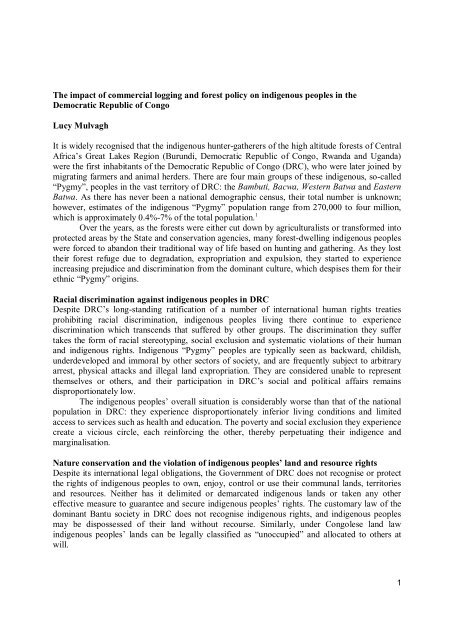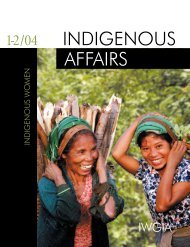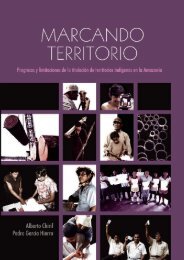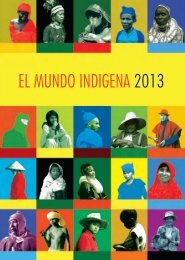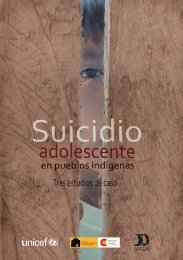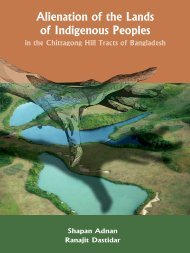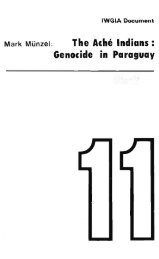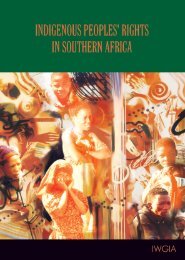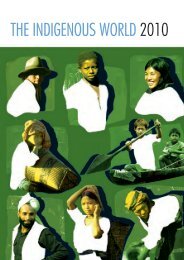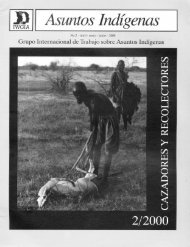Download (pdf) - iwgia
Download (pdf) - iwgia
Download (pdf) - iwgia
You also want an ePaper? Increase the reach of your titles
YUMPU automatically turns print PDFs into web optimized ePapers that Google loves.
The impact of commercial logging and forest policy on indigenous peoples in theDemocratic Republic of CongoLucy MulvaghIt is widely recognised that the indigenous hunter-gatherers of the high altitude forests of CentralAfrica’s Great Lakes Region (Burundi, Democratic Republic of Congo, Rwanda and Uganda)were the first inhabitants of the Democratic Republic of Congo (DRC), who were later joined bymigrating farmers and animal herders. There are four main groups of these indigenous, so-called“Pygmy”, peoples in the vast territory of DRC: the Bambuti, Bacwa, Western Batwa and EasternBatwa. As there has never been a national demographic census, their total number is unknown;however, estimates of the indigenous “Pygmy” population range from 270,000 to four million,which is approximately 0.4%-7% of the total population. 1Over the years, as the forests were either cut down by agriculturalists or transformed intoprotected areas by the State and conservation agencies, many forest-dwelling indigenous peopleswere forced to abandon their traditional way of life based on hunting and gathering. As they losttheir forest refuge due to degradation, expropriation and expulsion, they started to experienceincreasing prejudice and discrimination from the dominant culture, which despises them for theirethnic “Pygmy” origins.Racial discrimination against indigenous peoples in DRCDespite DRC’s long-standing ratification of a number of international human rights treatiesprohibiting racial discrimination, indigenous peoples living there continue to experiencediscrimination which transcends that suffered by other groups. The discrimination they suffertakes the form of racial stereotyping, social exclusion and systematic violations of their humanand indigenous rights. Indigenous “Pygmy” peoples are typically seen as backward, childish,underdeveloped and immoral by other sectors of society, and are frequently subject to arbitraryarrest, physical attacks and illegal land expropriation. They are considered unable to representthemselves or others, and their participation in DRC’s social and political affairs remainsdisproportionately low.The indigenous peoples’ overall situation is considerably worse than that of the nationalpopulation in DRC: they experience disproportionately inferior living conditions and limitedaccess to services such as health and education. The poverty and social exclusion they experiencecreate a vicious circle, each reinforcing the other, thereby perpetuating their indigence andmarginalisation.Nature conservation and the violation of indigenous peoples’ land and resource rightsDespite its international legal obligations, the Government of DRC does not recognise or protectthe rights of indigenous peoples to own, enjoy, control or use their communal lands, territoriesand resources. Neither has it delimited or demarcated indigenous lands or taken any othereffective measure to guarantee and secure indigenous peoples’ rights. The customary law of thedominant Bantu society in DRC does not recognise indigenous rights, and indigenous peoplesmay be dispossessed of their land without recourse. Similarly, under Congolese land lawindigenous peoples’ lands can be legally classified as “unoccupied” and allocated to others atwill.1
The forest plays an essential part in ensuring the physical, cultural, spiritual and economicwell-being of indigenous “Pygmy” peoples, who suffer extreme levels of poverty and ill-healthwithout it. Most believe their lives would be better if they lived in the forest, as it gives themaccess to a secure means of subsistence, medicinal plants and the ability to practise their customs.However, the integrity and security of indigenous peoples in DRC is under severe jeopardy dueto the creation of protected areas on their traditional lands and territories and the ongoing denialof access to these zones, to the extent that they have become what are known as “conservationrefugees”. 2Following expropriation of indigenous lands and forests and the expulsion of indigenouspeoples from these areas for conservation purposes, many have become landless squatters livingon the fringes of settled society. In order to survive, they have been forced to farm the lands ofothers in arrangements that are functionally equivalent to bonded labour. These communitieshave not received any compensation or other reparation for their losses and they continue to bedenied access to their lands that have been incorporated into national parks. 3For example, during the 1960s and 1970s, with no prior consultation or consent, hundredsof indigenous families were expelled from the Kahuzi-Biega forest in eastern DRC to make wayfor a nature conservation area for lowland gorillas. To this day, they have been denied access tothe area. Furthermore, they have not been recompensed for the loss of their traditional lands andresources or restrictions on access to the park, and their cultural integrity and well-being has beensubstantially harmed. 4Indigenous peoples expelled from Kahuzi-Biega receive no benefits from the nationalpark and have no participation in park management. Some are employed as trackers, and othersare temporarily employed for work such as road building, yet there is no comprehensive plan toaddress the issue of indigenous peoples’ rights. Indigenous territories expropriated to create theKahuzi-Biega National Park have become State land on which private activities are prohibited,thereby denying indigenous peoples their right to practise their traditional lifestyle and cultureand unilaterally extinguishing their property rights. The indigenous peoples expelled from thePark consider it to be their territory since time immemorial and maintain strong psychological,spiritual and cultural links with the forest. They dispute the expropriation of their lands, andlament their loss even today. Nevertheless, the Park authorities refuse to let them enter, and it isnot uncommon for indigenous people to report that they have been shot at or branded ‘poachers’and harassed or worse should they try to access the Park.Despite the ongoing fighting that is occurring within DRC, and the land and resourceexploitation that surrounds them, several indigenous communities have managed to retain theirforest-based hunter-gatherer lifestyle and culture with varying degrees of success. Thoseindigenous peoples who have done so have avoided the same level of racial discrimination anddeprivation that afflicts those who have been forced out of the forest. They are neverthelessfacing the same fate in the light of forest zoning plans that, without any regard for their rights,will substantially increase protected areas and commercial forest exploitation pursuant to the2002 Forest Code and with support from agencies such as the World Bank.Forest zoning and commercial resource exploitation, and the role of the World BankIn 2002, DRC adopted a new Forest Code and has subsequently begun adopting a series ofimplementing laws that put its provisions into effect. 5 The Forest Code determines how theCongolese forests will be zoned, with at least 40 percent allocated to commercial exploitation and15 percent to conservation. Although referred to as “protected” in the Code, the remaining forest– at least 45 percent – will also be subject to concessions; however the percentage of forest, if2
any, that will be regularised as indigenous-owned remains unknown and is not presently beingconsidered. 6While the World Bank has agreed to fund reforms in the forestry and mining sectors, 7indigenous peoples’ rights are not addressed in relation to these reforms and DRC presently hasno effective legal framework to regulate or control the environmental impact of forestryexploitation. According to the World Bank, the zoning plans in DRC could affect at least 300,000indigenous people and 35 million people in total who live in the forests or rely on them for theirsurvival. 8 Of great concern is the fact that there was no consultation with or participation byindigenous peoples in earlier pilot zoning projects carried out with the assistance of the WorldBank and the UN’s Food and Agriculture Organisation (FAO).Increased forestry exploitation in DRC by logging concessionaires is substantiallyexacerbating and intensifying the threat to indigenous peoples’ physical, cultural, spiritual andeconomic security, and has already resulted in further dispossession and irreparable harm.Forestry concessions are regularly granted without prior consultation with communities, evenwhen they live within the concession zone. Despite a forestry moratorium of May 2002 that wasextended to November 2005, 9 the State has admitted that logging continued in DRC, with thegranting of 103 concessions since the moratorium was put in place (equivalent to 147,426 km 2 offorest). 10 Moreover, the World Bank predicts a potential increase of 60 to 100 percent in loggingin DRC and the creation of a “favourable climate for industrial logging”. 11 A region equivalent to60 million hectares (i.e. an area bigger than France) is to be considered as “production forests”. 12A 2005 Presidential decree states that forestry concession titles granted prior to theadoption of the Forest Code must be “converted” into new titles otherwise the forest will revertback to State ownership. 13 The implementation of this legislation, also assisted by the WorldBank, has been put on hold during the election period, however it poses a further threat toindigenous peoples’ rights and livelihoods if the State does not carry out full and thoroughconsultations with indigenous peoples to ensure their informed participation, establish theircustomary property and use rights, and delimit and demarcate their lands and territories.Worryingly, there was no known consultation with or participation by indigenous communitiesprior to the list of conversion requests being published by the State, 14 despite assurances by theWorld Bank that consultations with indigenous peoples should follow the principles of free, priorand informed consent. 15 At the very least, all concessions granted after the moratorium should bedeclared illegal and their titles rescinded.In October 2005, indigenous peoples’ organizations filed a formal complaint with theWorld Bank’s Inspection Panel, seeking an investigation of the Government and World Bankactivities. Amongst other things, this complaint alleges serious violations of World Banksafeguard policies relating to indigenous peoples and environmental impact assessments. TheInspection Panel’s eligibility report notes that the World Bank has recognised that it may haveacted too quickly in its support of forestry sector reforms, and that the Bank was not in fullcompliance with its safeguard policy on indigenous peoples (Operational Directive 4.20). 16Despite recognising the importance of “reaching out” to indigenous communities, the Bankclaims it did not do so because the “forest areas were still inaccessible”. 17 The Bank recognisedits failure to adequately consult with indigenous communities and the need to “establish moredirect lines of communication with Pygmy leaders and communities”, and has committed topreparing an Indigenous Peoples’ Plan. 18Following an initial visit to DRC in January 2006 to consider the eligibility of the formalcomplaint, the Inspection Panel announced that it would carry out a full investigation. 19Unfortunately a further Panel visit scheduled for May 2006 was postponed, due to reported3
insecurity in the run-up to national elections, as was a rescheduled visit in October 2006. ThePanel has very recently indicated that it will now schedule its visit for February 2007. The Panelcannot publish its investigation report until after this country visit. At the time of writing thisarticle, there is no indication of what findings the Panel may publish, or what decisions the WorldBank Board of Directors will take in the light of the report. As its jurisdiction only extends to theWorld Bank, however, action is still required to address the State’s acts and omissions that haveresulted in the threat of immediate and irreparable harm to indigenous peoples in DRC.Forestry legislation discriminates against indigenous peoplesThe 2002 Forest Code is blatantly discriminatory as it fails to recognise the existence ofindigenous peoples and protect their rights. It does not recognise or respect indigenous peoples’distinct forms of socio-cultural and political organization and forces them to adopt alienorganizational structures in order to obtain title to their lands. Further, it exposes them to thethreat of continuing the pattern of domination and coercion by neighbouring Bantu who falselyclaim to represent indigenous peoples and their interests.The provisions governing forestry use rights also discriminate against indigenous peoplesand violate their rights to a secure means of subsistence and to freely dispose of their naturalwealth. Some provisions state that local communities have use rights for “domestic” purposesonly, which constitutes a direct threat to the physical and socio-economic well-being ofindigenous peoples who wish to sell or exchange their forest resources, for example tosupplement household incomes or provide funding for healthcare. Use rights in gazetted and“protected” forests are extremely limited and fail to recognise or respect indigenous peoples’rights: they do not recognise hunting as a legitimate activity, and prohibit any use other than fordomestic purposes. All use rights, including traditional indigenous livelihood and culturalpractices such as hunting and fishing, are banned in conservation areas.There are also several instances where the forestry legislation violates indigenouspeoples’ rights to judicial remedies and protection and to due process of the law. For example,there is no appeal procedure provided for when adopting gazetting plans or granting forestryconcessions on indigenous peoples’ traditional lands and territories, and no appeal procedureagainst forestry concession management plans which may violate indigenous peoples’ rights.The Forest Code clearly indicates the State’s desire to prioritise commercial andconservation use of the forests over community forests. It fails to recognise indigenous peoples’ownership of their lands, territories and resources, their rights to collective title and theirtraditional land tenure systems. It also fails to delimit, demarcate and title indigenous peoples’lands, and to respect and protect their use and access rights.Despite assurances by the State that there would be active participation by localcommunities and NGOs in forestry sector reforms, 20 to date there has been virtually no publicconsultation, and public knowledge about the forestry legislation is severely limited. The Codecontains no requirements that indigenous peoples should be meaningfully consulted or participatein decision-making, or that the State should obtain their free, prior and informed consent toactivities on their lands, particularly with regard to forest zoning and management plans,gazetting and commercial forestry concessions. In fact, there is no such requirement in any otherlaw in force in DRC. The Code’s implementing regulations contain multiple additional examplesof the State’s failure to respect indigenous peoples’ rights to participate in decision-making andto give their free, prior and informed consent to activities on their lands and territories, includingin the elaboration, implementation, monitoring and evaluation of forestry concessionmanagement plans. The elaboration and adoption of further implementing regulations was4
suspended during the election period. At the very least, any future such activities that may takeplace after the elections must include the participation of indigenous peoples and ensure that theirfree, prior and informed consent is sought in relation to activities which may affect them, theirlands, territories and resources.ConclusionIndigenous peoples in DRC experience widespread, persistent and systematic racialdiscrimination and violations of their human and indigenous rights. Their rights to own, control,use and peacefully enjoy their lands, territories and resources are neither recognized norguaranteed in Congolese law and these rights are frequently violated in practice, especially inconnection with the forestry legislation, forestry exploitation and nature conservation.The failure to recognize and guarantee these rights has led to gross violations ofindigenous peoples’ human rights, undermining their means of subsistence and severelycompromising their physical, cultural and economic integrity. The State has so far beenunresponsive to the efforts made by indigenous peoples to resolve questions surrounding theirrights. These efforts have included: forming a coalition with several indigenous and internationalenvironmental and human rights organisations; submitting a series of complaints to the State andthe World Bank; submitting a formal request to the World Bank’s Inspection Panel, andsubsequent follow-up; and carrying out a series of community consultation and sensitizationworkshops to inform indigenous communities about the situation and obtain their views. Despitethese complaints and other advocacy work, the State has not sought to meet with indigenouspeoples’ representatives nor has it taken any action to address their concerns in relation to theimpact of the forest policy and commercial concessions on their rights.Indigenous organisations, national and international NGOs should continue their call forpositive change in the law and its implementation in DRC to ensure that indigenous peoples’rights are recognized and guaranteed. The State must address the ongoing widespread, persistentand systematic gross violations of indigenous peoples’ rights caused by racial discrimination,forestry legislation and resource exploitation. Without urgent action, the lands, territories andresources of indigenous people in DRC will continue to be irreversibly degraded, depriving theaffected peoples of the source of their physical, cultural, economic and spiritual sustenance, andthreatening their very existence.This article has been adapted from a submission by Forest Peoples Programme and sixindigenous partner organisations to the United Nations’ Committee on the Elimination of RacialDiscrimination, requesting initiation of an early warning and urgent action procedure to addressthe threat of immediate and irreparable harm to indigenous peoples in DRC. For the full report,see www.forestpeoples.org.Lucy Mulvagh is a Project Officer with Forest Peoples Programme (FPP), an internationalNGO that works in partnership with indigenous, tribal and forest peoples throughout the worldto help them secure their individual and collective rights and maintain control of their lands andnatural resources. FPP has worked with indigenous peoples in central Africa since 1991 and inDRC since 1998, and has published several reports on the situation of indigenous peoples in thisregion and elsewhere. Email: info@forestpeoples.org.5
Notes1 The estimate of 270,000 is found in the African Commission on Human and Peoples’ Rights Report of the AfricanCommission’s Working Group on Indigenous Peoples/Communities (2005), page 6; while the estimate of 4,000,000is found in ARD, Inc. Conflict Timber: Dimensions of the Problem in Asia and Africa, Volume III: African Cases –Final Report Submitted to the United States Agency for International Development, Vermont, USA, page 17.2 The term “conservation refugees” was developed to describe the massive and debilitating impact of conservationactivities on indigenous peoples in Central Africa, such as the establishment of national parks, which “puts the rightsof nature before the rights of people” and which has resulted in their forcible dispossession and displacement. See:Dowie, M., Conservation Refugees: When protecting nature means kicking people out in Orion Magazine, Nov/Dec2005, available online at: http://www.oriononline.org/pages/om/05-6om/Dowie.html.3 See Lewis, J. and Knight, J. (1995), The Batwa of Rwanda: Assessment of the Situation of the Batwa andPromotion of Batwa Rights in Post-War Rwanda (WRM and IWGIA, Copenhagen); Woodburn, J. (1997),Indigenous discrimination: the ideological basis for local discrimination against hunter-gatherer minorities in sub-Saharan Africa, in Ethnic and Racial Studies, Vol.20, No.2, pp.345-361; Lewis, J. (2000), The Batwa Pygmies of theGreat Lakes Region (MRG, London); Barume, A. K. (2000), Heading Towards Extinction? Indigenous rights inAfrica: the case of the Twa of the Kahuzi-Biega National Park, Democratic Republic of Congo (IWGIA,Copenhagen); Jackson, D. (2003), Twa women, Twa rights (MRG, London); Nelson, J. and Hossack, L. (Eds)(2003), Indigenous peoples and protected areas in Africa: From principles to practice (FPP, Moreton-in-Marsh);African Commission on Human and Peoples’ Rights (2003), Report of the African Commission’s Working Group onindigenous peoples/communities (ACHPR, The Gambia).4 Barume, A. K. (2000), Heading Towards Extinction? Indigenous rights in Africa: the case of the Twa of theKahuzi-Biega National Park, Democratic Republic of Congo, op. cit.; Nelson, J. and Hossack, L. (2003), IndigenousPeoples and Protected Areas in Africa: From Principles to Practice, op. cit.5 Loi 011/2002 du 29 Août 2002 Portant Code Forestier (Law 011/2002 of 29 August 2002, Forest Code). Alltranslations of the 2002 Forestry Code and implementing regulations are unofficial translations by the author.6 Forest Peoples Programme and Réseau des Associations Autochtones Pygmées (June 2004), Guide pour lacompréhension du Code forestier à l’usage des populations locales et du peuple autochtone ‘Pygmée’, page 10.7 World Bank, Democratic Republic of Congo: World Bank Approves US$90 million Budget Support Operation,Press Release No. 2006/296/AFR, available at:http://web.worldbank.org/WBSITE/EXTERNAL/COUNTRIES/AFRICAEXT/CONGODEMOCRATICEXTN/0,,contentMDK:20750090~menuPK:349472~pagePK:141137~piPK:141127~theSitePK:349466,00.html.8 Jackson, D. (2005), Implementation of international commitments on traditional forest-related knowledge:Indigenous peoples’ experiences in Central Africa, (FPP, Moreton-in-Marsh), p. 44.9 Ministère de l’Environnement et Ministère de Finances de la République démocratique du Congo, Communiqué dePresse, No. 3519, 1/11/2005. This Press Release by the DRC Ministries of the Environment and Finance lists 141existing forestry concessions as at 29 October 2005, of which at least 103 were granted since the moratorium.10 Ibid.11 Rainforest Foundation UK, Briefing Paper: New threats to the forests and forest peoples of the DemocraticRepublic of Congo, February 2004 citing the following reports: World Bank, Democratic Republic of Congo, Missionde Suivi Sectoriel, 17-27 April 2002; World Bank, Democratic Republic of Congo Mission de Suivi Sectoriel, 1-12July, 2003; World Bank, Democratic Republic of Congo, Mission de Suivi Sectoriel, 17-27 April 2002. Available at:http://www.rainforestfoundationuk.org.12 Ibid.13 Décret No. 05/116 du 24 Octobre 2005 Fixant les Modalités de Conversion de Concession Forestière et PortantExtension du Moratoire en Matière d’Octroi des Titres d’Exploitation Forestière.14 By February 2006, 73 title holders requesting 235 concession conversions had been registered. See Républiquedémocratique du Congo, Ministère de l’Environnement, Conservation de la Nature, Eaux et Forets, CommuniquéOfficiel No. 001/CAB/MIN/ECN-EF/2006, 02/02/2006.15 Letter from Mr. John McIntire, Sector Director, Rural, Environmental and Social Development, African Region,World Bank on “World Bank involvement in the forest sector of the Democratic Republic of Congo” to Mr. JohnBuckrell, Global Witness, 4 April 2006.16 The Inspection Panel, Report and Recommendation on Request for Inspection, Democratic Republic of Congo:Transitional Support for Economic Recovery Credit Operation (TSERO) (IDA Grant No. H192-DRC) and6
Emergency Economic and Social Reunification Support Project (EESRSP) (IDA Credit No. 3824-DRC and IDAGrant No. H064-DRC), undated, paras. 47, 25 and 41.17 Ibid, para. 48.18 Ibid, and para. 41.19 Ibid., para. 66.20 See, for example, République démocratique du Congo, Ministère de l’Environnement, Conservation de la Nature,Eaux et Forets, Forum des Nations Unies sur les Forets, Rapport National 2004, 13 janvier 2004, Point A.2 (page 9),Point A.3 (page 11).7


